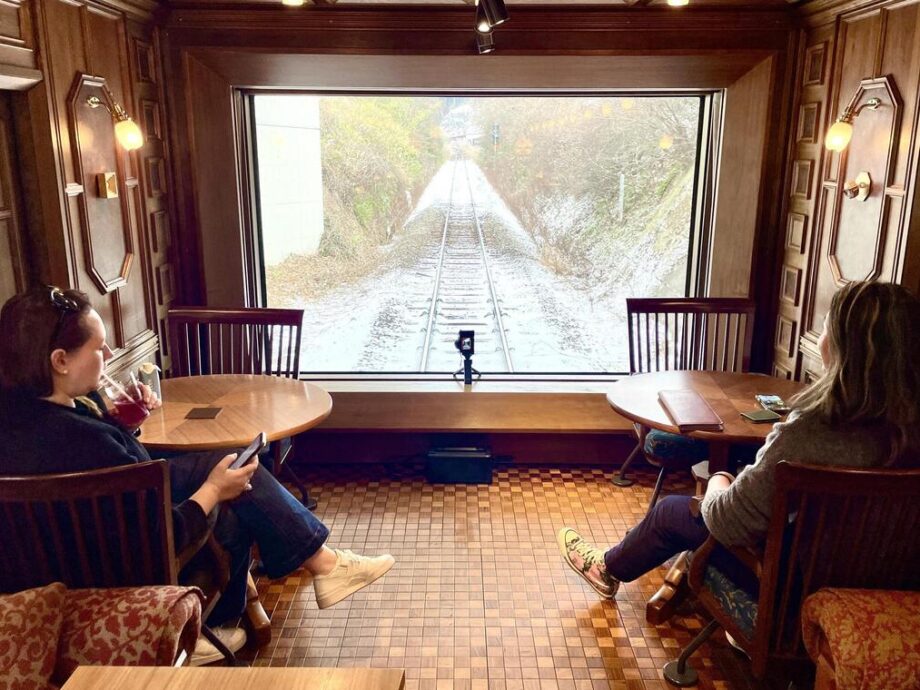A coveted ticket on Japans most exclusive train
Seven Stars in Kyushu has a reputation that precedes it. It is one of the worlds most expensive rail journeys and one of the hardest to book. The starting fare for the shortest overnight itinerary sits around 680,000 yen for a twin sharing cabin, roughly S$5,900 at recent exchange rates. Getting a seat takes more than budget. Tickets are released by application and awarded by lottery because demand far outstrips supply. Fewer than five in every hundred hopefuls secure a place in some seasons. The train has only ten cabins, usually a maximum of about twenty guests, and a crew trained in Japanese omotenashi, the art of thoughtful hospitality.
Scarcity is part of the allure. So is the style of travel. Interest in slow, scenic rail journeys surged after the pandemic. Travelers wanted comfort, craft and connection, not just a fast transfer between cities. Seven Stars channels that mood with classic interiors, regional craftsmanship, and long looks at Kyushus forests, rice paddies and volcano lined coasts. At many local stations, families and rail fans come out to wave. The train becomes a moving celebration, and guests are invited into that ritual.
The core question is whether the experience justifies the price. That depends on what the fare actually buys, how it compares with other luxury trains, and the type of traveler you are. Here is what to expect on board and off, how the itineraries work, and where the value sits for different kinds of trips.
What exactly do you get for the fare
From the first minute the tone is set. Guests meet at an exclusive lounge inside Hakata Station in Fukuoka for a welcome and briefing. Luggage is handled by staff, drinks are poured, and a small ceremony marks departure. Boarding is through a priority gate. The deep burgundy train arrives with the precision that Japanese rail is known for. Stepping inside is like walking into a gallery of Kyushu artisanship curated by a railway designer with a love for detail. Carriages glow with walnut and rosewood, kumiko latticework appears in walls and doors, and shoji screens soften the light. Every fitting nods to craft traditions from across the island.
Cabins and suites
The train carries twelve standard suites and two deluxe suites. Standard suites are compact by hotel standards but generous for a luxury train, with a sitting area that converts to twin beds at turndown, and a private toilet and shower. Windows are large enough for unbroken views of passing mountains and sea. The two deluxe suites are much larger. One faces the rear picture window, a dramatic choice for guests who want wide angle views of the tracks behind. Bathrooms feature cypress lined showers and porcelain basins from famous Kyushu kilns. Details matter here. Wood ceilings, hand finished fixtures and art pieces create a sense of traveling in a private residence rather than a carriage.
Dining and lounges
Dining is the showpiece. Menus change by day and region. Chefs from across Kyushu design courses that might move from delicately seasoned crab to wagyu from Kagoshima to seasonal fish paired with vegetables sourced near the route. Lunches and dinners are choreographed in the Jupiter dining car. The Blue Moon lounge car functions as a salon with a bar, a picture window, and live music in the evening. Tea ceremonies and tastings may be hosted in a small tearoom with tatami. A bar car seats only a handful of guests, which encourages conversation with the bartender and fellow travelers. The beverage list leans into Kyushus strengths, from shochu and sake to a careful wine selection and champagne.
Routes and excursions across Kyushu
Seven Stars runs two core itineraries. The shorter journey is two days and one night across northern Kyushu, often including stops such as Arita for porcelain heritage and scenic points near Mount Aso or Nagasaki. The signature journey runs four days and three nights around the island. It usually includes a night at a luxury ryokan off the train, then a return to the carriages with new menus and new scenery. The long route ranges from the mountains and hot springs of Oita to the volcanic south around Kagoshima, then back north along the sea. On clear days there are views of Sakurajima volcano sending curls of steam into the sky.
Sample highlights
- Arita and Imari porcelain, with visits to historic kilns and workshops that supply lamps, basins and tableware used on the train
- Onta pottery village, where clay is still processed by water powered stamp mills and pots are fired in wood kilns
- Ryokan stays with private onsen, garden to table dining, and wakes to mountain views in places like the Kirishima range
- Guided walks at Lake Kinrin or around the plains at Aso for long horizon views of Kyushus rural heart
- Coastal legs that track along the sea, including stretches on the Hisatsu Orange Railway with small station welcomes
- Evening entertainment back on the train, from live piano and violin to intimate magic at your table
Excursions are paced. You are never rushed through a checklist. The emphasis is on meeting artisans, tasting regional dishes, soaking in hot springs, and seeing countryside that most visitors miss when they fly or ride only the Shinkansen. That philosophy shapes the entire trip. It is a curated introduction to Kyushu, its food, its craft, and its landscapes.
Service that sets a high bar
The service culture is the trains calling card. Omotenashi is a Japanese approach to hospitality that anticipates needs before they are voiced. Staff remember preferences. Interpreters assist international guests. There is help with everything from shoes to camera angles on the platform. With only about twenty travelers, crew members learn names within hours. Timing feels seamless, from luggage choreography to a glass arriving just as you notice the sunset. The human connection extends beyond the train too. Station gatherings with locals turn departure into a small festival, complete with waves and smiles that linger well after the train moves on.
Comfort touches show up in quiet ways. Turndown comes while you dine. Tea appears just after breakfast. Cabins are kept pristine. The lounge becomes a shared living room in the afternoon and an intimate venue at night. Nothing feels hurried. The rhythm is gentle. You look forward to returning to the carriage after each excursion, which is the surest sign that the train itself is the destination.
How the price compares
Sticker shock is understandable. The original lottery entry many travelers pursue is the overnight journey at about 680,000 yen for a twin shared cabin. The cost per person drops if you share, but it remains a premium. Longer itineraries command higher rates. Four day programs, which include the off train ryokan night and wider coverage of the island, reach the top tier of luxury rail pricing in Japan. Deluxe suites and peak dates can approach or exceed one million yen per person for multi night stays. A recent range across seasons places the shorter trips at roughly the equivalent of four to six thousand US dollars per person, and the longest at well over ten thousand for the highest categories (pricing shifts by season and cabin type).
In global context, Seven Stars sits with the most prestigious names in rail travel. In Japan, it shares a rarified club with Twilight Express Mizukaze and Train Suite Shiki Shima, both complex, design forward trains with their own multi day itineraries and suites with private baths. Abroad, it is frequently mentioned in the same breath as Venice Simplon Orient Express in Europe, the Royal Scotsman in the United Kingdom, and Rovos Rail in South Africa. Those trains can cost similar amounts per night for top suites. Where Seven Stars differs is the intimacy. Ten cabins and a strong sense of place give it the feel of a house party that happens to roll through volcano country.
Value depends on how you weigh several elements. A night in a Kyushu luxury ryokan, a gourmet tasting menu with drink pairings, a private guide for artisan visits, and private transfers would already add up quickly if booked separately. The train bundles those pieces with a moving base of operations and near continuous service. If you only need transport from A to B, the fare will not make sense. If you are drawn to craft, cuisine and the quiet spectacle of a landscape unfurling by rail, the calculus changes.
Is it worth it, and for whom
For design lovers, rail fans, and travelers who prize service and story over square footage, the answer tends to be yes. The train is a celebration of Kyushu. You taste the island, meet its makers, sleep in comfort, and wake to views that shift from misty mountain to bright sea. Anniversaries and milestone trips are the sweet spot. Couples, small friend groups, and multi generational pairs often find the setting ideal because everything is handled and the days strike a balance between activity and rest.
It is less suited to travelers who want full control of their schedule, who prefer spontaneous detours, or who need lots of space to spread out. Cabins are beautifully made but still cabins. Wi fi and mobile signals can drop in remote stretches. Families with very young children may find the cadence too quiet. Budget conscious travelers will see better returns by creating their own Kyushu route and staying in local inns, then reserving splurge meals along the way. That alternative can be deeply rewarding, just a different style of trip.
How to apply and raise your chances
Applications open by season and close quickly. You submit preferences for dates, itinerary, and cabin type, then wait for the lottery result. Demand is high, and acceptance rates can be in the single digits for popular windows like spring cherry blossom or fall colors. If selected, you receive a confirmation and payment schedule. If not, you can opt to stay on a waiting list or reapply for a later season.
A few tactics help. Flexibility is the single biggest advantage. Consider both itineraries. Select a range of departure windows, not just the most obvious holiday weeks. Indicate that you can accept a standard suite if a deluxe is unavailable. Be ready to respond within hours if a waitlist place opens. Keep passport details and dietary notes ready for forms. Pack lighter than you think you need. Bags are handled for you, yet soft luggage is easier to stow and makes the cabin feel spacious. Finally, build a wider Kyushu trip around the train rather than trying to stack other commitments tight against the departure. A day on either side in Fukuoka takes the stress out of a once rare booking.
The Bottom Line
- Seven Stars in Kyushu is one of the worlds most exclusive trains, with only ten cabins and a lottery to book.
- The starting overnight fare is about 680,000 yen for a twin sharing cabin, and longer itineraries cost more by season and suite.
- Interiors showcase Kyushu craft, from kumiko woodwork to porcelain from famous kilns, with private bathrooms in all cabins.
- Dining is central, with rotating chefs, regional menus, and a lounge car with live music and a well stocked bar.
- Itineraries include a shorter two day route in the north and a four day circuit with a ryokan stay and deep regional excursions.
- Service follows omotenashi, with interpreters and a guest count small enough for highly personalized care.
- Compared with other luxury trains in Japan and abroad, Seven Stars trades on intimacy, craft, and a strong sense of place.
- Worth it for travelers seeking a curated, celebratory experience of Kyushu; less useful if you want flexible, budget travel.




